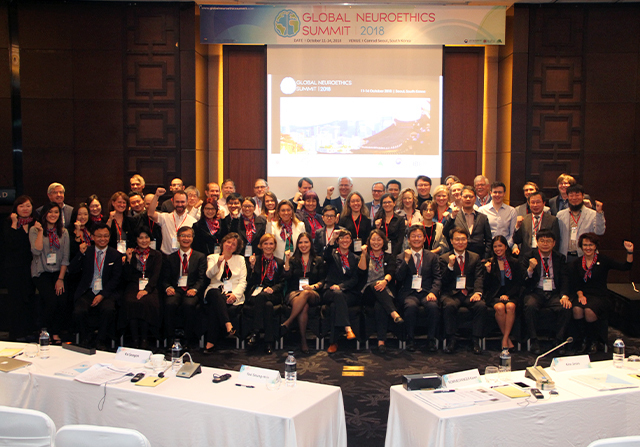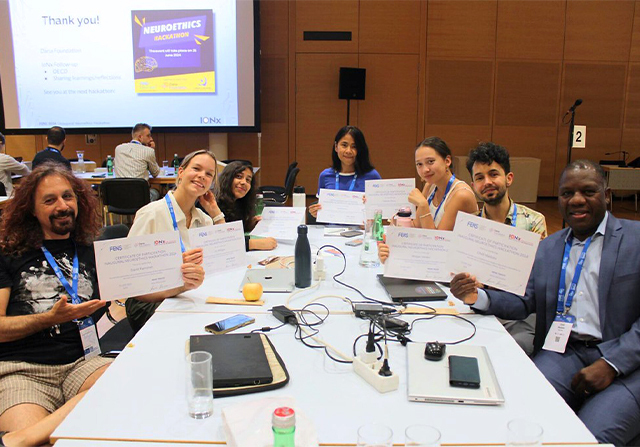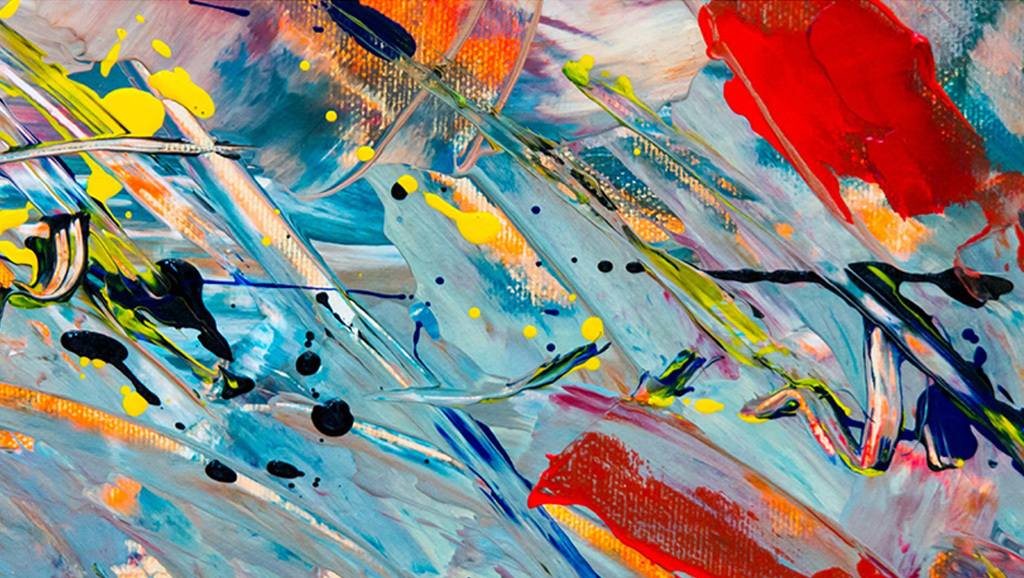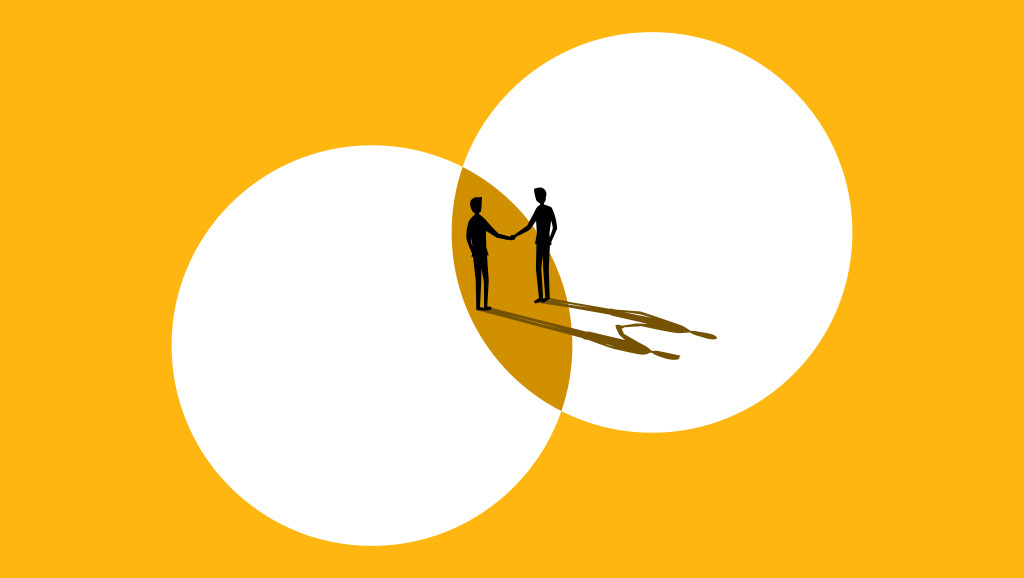News & Insights
Karen Rommelfanger: A Neuroscience & Society Champion of Ethics and Inclusion
Recipient of the Dana Foundation Neuroscience & Society Champion Award, in honor of Charles A. Dana

Karen Rommelfanger, Ph.D., a pioneer at the intersection of neuroscience, ethics, and global society, was honored by the Dana Foundation last week as one of two inaugural recipients of its Neuroscience & Society Champion Awards. As founder of the Institute of Neuroethics Think and Do Tank, Rommelfanger brings together communities across cultures and disciplines to ensure that ethical questions keep pace with rapid advances in brain science and new neurotechnologies. Here, she reflects on her career, inspirations, and her approach to building bridges within science and society.
Q: You first trained as a bench neuroscientist. What inspired your transition into neuroethics and public engagement?


Rommelfanger: From the beginning, I was deeply curious about the human implications of neuroscience. Early books like The Astonishing Hypothesis by Francis Crick and Candace Pert’s Molecules of Emotion got me thinking about how our brains are related to who we are. During my doctoral work on Parkinson’s disease, and later as a postdoc listening directly to neurons firing, I had an epiphany: Neuroscience alone could never fully encompass the human mind. Engaging with patients and clinicians further alerted me to the societal biases underlying medical diagnosis, particularly as they relate to the brain. These experiences sparked a pivotal realization: If the brain defines who we are, neuroscience must actively engage society, policy, and ethics.
What led you to focus so much on bridging divides across cultures and disciplines?
My drive to bridge cultures comes from my upbringing. My dad was raised in a German-Catholic family, and my mom was raised in a strict Buddhist family from Taiwan. We lived in Japan for years before moving to West Texas—you really can’t get more different than that! That early exposure to dramatically different perspectives made me acutely aware of how narrow most mainstream ethical discussions were, and it helped me become comfortable moving between worlds, whether they be disciplines or cultures. Now I feel at home—or at least not freaked out—in almost any environment, which is essential when trying to build bridges in global neuroethics.
You’ve emphasized the value of creating safe spaces to help bridge divides. Why is that critical to your work?
Interdisciplinary and diverse conversations aren’t easy. They require intentional spaces, crafted carefully, allowing everyone to feel comfortable honestly sharing ideas, doubts, and even disagreements. Often, the most creative solutions come from leaning into discomfort and difference. With efforts like the Global Neuroethics Summit and our Federation of European Neuroscience Societies (FENS) Neuroethics Hackathon, participants often told us how meaningful it was that these events enabled authentic dialogue across cultures and professional backgrounds.
We aim to not just create safe spaces but to model these types of interactions, including specifying an openness to cultural curiosity and awareness of unspoken assumptions—an important one being that when it comes to ethics, the discussion is far from black and white answers. Especially following the isolating Covid pandemic, it’s become so clear how essential trust, openness, and safety are to meaningful progress. Without these spaces, ethical innovation and genuine collaboration just aren’t possible.
Can you elaborate on why the Global Neuroethics Summit was so impactful?
Neuroscience is global, but ethical discussions often aren’t reflective of diverse global perspectives. The Summit sought explicitly to bridge cultural divides by bringing the voices of brain scientists, ethicists, policymakers, and industry partners from around the world together—in our case, starting in South Korea. The outputs, including a foundational set of neuroethics questions, have since guided researchers internationally. Importantly, this summit wasn’t just about abstract conversations. It fostered a genuinely international, cross-cultural ecosystem of collaborators who learned, shared, and grew trust together.


How do you move neuroethics from theory into practice—whether through your Institute or through your consultancy Ningen Neuroethics Co-Lab?
Ethical guidelines in isolation become little more than thoughtful doorstops. Through our Institute of Neuroethics’ Think and Do Tank, we aim to put ethics directly into action. We use what we call a co-CREATE framework: collaboratively generating real solutions, tools, and guidance across disciplines and sectors. We specifically include voices traditionally missing from ethics conversations—like those with lived medical experiences and industry stakeholders developing neurotechnology. They offer a critical lens for what it means to grapple with real world tensions in translating a critical scientific discovery or engineering feat into the real world, or from bench to bedside. This includes designing features that truly suit patients day to day and considering the multiple ways a technology could be used even beyond the clinic.
I also started a separate boutique consultancy—the first formal neuroethics strategy consultancy—to work directly with companies and other organizations, helping them build ethical practices that go beyond “ethics washing” and adopt a proactive neuroethics-by-design approach. Every client must agree that I can share general lessons publicly, so we build knowledge for the whole field. My goal is to create exemplars, showing that implementing ethics strategies aren’t just possible but can become a model for leadership, whether in policy, industry, or academia.
What should multidirectional, co-creative public engagement look like, especially in different cultural settings?
True engagement means more than just scientists talking at the public. We’re committed to multidirectional dialogue—real exchange, not just top-down communication. That’s particularly challenging but rewarding in places like Japan, where efforts in public engagement are growing, but the concepts are still evolving. It’s labor-intensive and sometimes uncomfortable, but absolutely essential if we want to build trust and relevance. We’re not aiming for utopia or simply avoiding dystopia—the goal is a co-created future, warts and all.
One recent project you mentioned earlier was the Neuroethics Hackathon at the FENS meeting, supported by the Dana Foundation and FENS. Could you tell us more?
We wanted early-career neuroscientists to have a creative way to tackle ethics concretely in real-time. Participants became imaginary neurotech companies tasked with defending ethical viability to policymakers, using scenario and provocation cards to imagine near-future technologies and grapple with tough dilemmas—like agency, inclusion, and mental privacy. Within a tight timeframe, they developed sophisticated, ethical frameworks and presented compelling solutions to a panel of mock policymakers.


What amazed me was how, in just a few hours, they came up with thoughtful, concrete strategies, involving ethics-by-design engineering strategies, deploying advisory panels at early stages for engagement, and more, that would challenge even seasoned professionals. It’s clear the next generation craves not just theoretical conversations, but hands-on, interdisciplinary engagement with ethics.
You’ve emphasized collaborating with industry partners, including through your work with BrainMind. Why is industry engagement so critical to your mission?
Ethical neuroscience can’t stay exclusively within the academy or policy groups. Industry partners bring neurotechnologies directly into people’s lives, but they often face significant pressure from investors and resource constraints, including money, federal device approval processes, and time. If we want ethical innovations reaching society, collaborating with companies and investors and deeply understanding their realities is essential. BrainMind is a powerful ecosystem of entrepreneurs, investors, and scientists aiming to build a culture of ethical innovation, and in partnering with them as Ningen Neuroethics Co-Lab, we’ve been able to cultivate early adopters of neuroethics working to build ethics directly into their core missions, products, and investment practices.
What advice do you offer to people drawn to neuroethics and societal engagement?
I always tell them: It doesn’t really matter what it’s called—neuroethics, engagement, policy. Start by understanding what excites you, what your strengths are, and what kind of impact you want to have. Find mentors who believe in big, interdisciplinary thinking. Be ready to listen deeply—particularly to perspectives very different from your own—and begin building relationships of trust early.
Neuroethics thrives in communities embracing dialogue, courage, and diversity. It isn’t about theories alone: Be dedicated to practical solutions that can genuinely serve society. Focus on the impact you want to have in the world and see and consider some kind of metric-how would you know that you’ve met your goals? And remember: Don’t take “no” from anyone who doesn’t have the authority to say so.
What do you hope your work helps change most in neuroscience and society?
I hope I’ve helped show that ethical, inclusive science isn’t just a theoretical, feel-good afterthought, but is vital to real progress. If we build spaces for genuine dialogue—across cultures, backgrounds, and sectors—and focus on empowering all voices, neuroscience can not only answer profound questions but also serve society in the most transformative ways.



